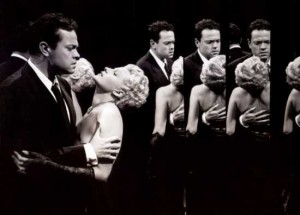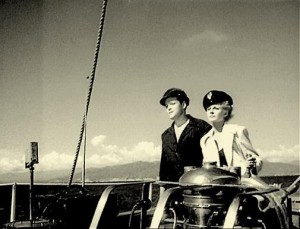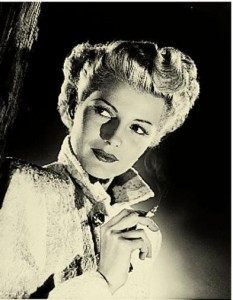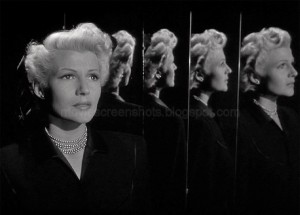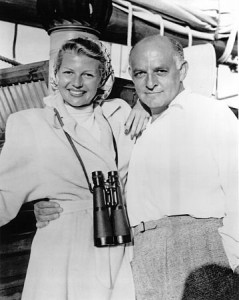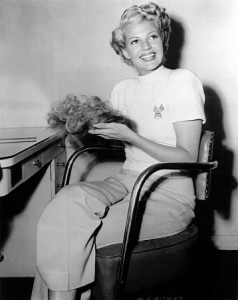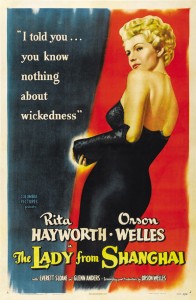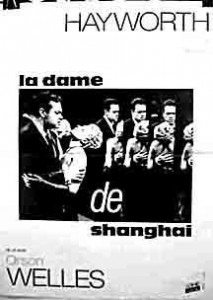The Lady from Shanghai ***** (1947, Rita Hayworth, Orson Welles, Everett Sloane) – Classic Movie Review 747
Dusting himself off in 1947 after all his troubles on Citizen Kane and The Magnificent Ambersons, Orson Welles writes, produces, directs and stars in the teasing, exhilarating 1947 film noir tour de force The Lady from Shanghai, which breaks most of the usual the usual rules of narrative story-telling on its triumphant way to perplexing, frustrating and finally delighting audiences.
Yet it was another typical Welles troubled production, with Welles’s original rough cut running 155 minutes until Columbia Pictures executives made numerous cuts, including a shortening of the famous funhouse climax. The film eventually ran original release. When the film was first screened for Columbia president Harry Cohn, he found it so incomprehensible he offered to pay $1,000 to anyone who could explain the plot to him. He later told Welles he would never again hire one man to write, produce, direct and act because that way he could never fire him.
The endlessly twisting plot sees Welles, sporting a weird, lilting Irish brogue as seaman for hire Michael O’Hara, who meets and instantly falls under the spell of the gorgeous blonde Mrs Elsa Bannister (played by Rita Hayworth), as she rides a horse-drawn coach at night in Central Park. Three hooligans waylay Elsa in the park, but Michael punches them out, rescues Elsa and escorts her home.
Elsa says she and her husband, sinister disabled criminal defence attorney Arthur Bannister (Everett Sloane), are newly arrived in New York City from Shanghai and they are sailing to San Francisco via the Panama Canal. Michael, dangerously mesmerised by Elsa despite all his misgivings, eventually reluctantly agrees to sign on as a crew member aboard Bannister’s yacht and join their bizarre yachting cruise.
While aboard, he completely falls for the seductive siren Elsa Bannister, under the nose of her husband, the owner of the yacht. O’Hara and Elsa begin a relationship that spirals into tragedy as the sailor ends up embroiled as the patsy in an ultra-complicated murder plot.
At sea, they pick up George Grisby (Glenn Anders), Bannister’s law partner. After they dock in Sausalito, Michael goes along with Grisby’s weird plan to fake his own murder so that he can disappear. O’Hara wants the $5,000 Grisby has offered so that he can run off with Elsa.
But then Grisby shoots Sydney Broome (Ted de Corsia), a private investigator following Elsa on her husband’s orders. Broome has learned of Grisby’s plan to murder Bannister, frame Michael and escape by pretending also to have been murdered. Then Grisby is murdered for real and Michael is blamed for it. But of course somebody has set him up…
This brilliant film noir mystery thriller is packed with vintage sequences – the much copied mirror-hall gunfight finale, the love scene set in the San Francisco Aquarium, the conversation on the Acapulco cliffs, the visit to the Chinatown theatre, Hayworth singing sweetly, sensuously and seductively while sunning herself on board the yacht.
Because of the success of Hayworth’s singing in other films, most notably Gilda, Columbia studio boss Harry Cohn ordered filming of the scene where Hayworth sings Please Don’t Kiss Me. Welles might not have wanted it but this just adds to the film’s charms. Cohn also ordered Welles to insert gratuitous huge glamour close-ups of Hayworth. Welles had deliberately avoided these, and now the film is jarringly though intriguingly spattered with them. It is great to spend so long just gazing on Hayworth’s glorious face. And the actress seems up for it, seemingly calculating as she is smouldering in the dominating close-ups.
Even so, and after extensive editing and re-shoots by Columbia studio assistants and an hour chopped from Welles’s final cut, Cohn still believed the movie would ruin Hayworth and held up its US release for a year until 9 June 1948 while more and more work was done on it.
Alas, the missing footage has never been found and is now presumed destroyed, but surviving production stills show elaborate, expensive sets built for the climactic confrontation scene in the amusement park funhouse that are entirely cut from the film. Welles was appalled at the cuts to this scene, with only three minutes left out of an intended running time of 20, and by Heinz Roemheld’s unsubtle score.
The character acting in the movie is sensational, with Everett Sloane, Glenn Anders, Ted de Corsia and Erskine Sanford (as Michael’s trial judge) producing fireworks among the cast. The Irish accent apart, Welles himself is on top form as the knowing but strangely innocent sailor victim pulled into a web of deceit and betrayal, and Hayworth of course makes a perfect, gorgeous femme fatale.
It was intended by Welles as his love letter to Hayworth, but ironically by the time it was filmed between 2 October 1946 and 27 February 1947 (with retakes in March), they were on the point of divorcing. Their marriage lasted from 7 September 1943 to 1 December 1948, and they had one child together.
Welles’s fine, characterful screenplay is based on Sherwood King’s pulp novel If I Die Before I Wake. Charles Lawton Jr’s black and white cinematography is an always startling, eye-catching marvel.
Welles said he only made the film to save his Mercury Theatre stage production of a musical version of Around the World in 80 Days, which had run out of money and was going to be closed down hours before it opened for its Boston try-out. He phoned Harry Cohn, asking him to buy the rights to the novel and offering to write, direct and star in the film if Cohn would send $55,000 to Boston within two hours. The money arrived, and the show went on.
Errol Flynn can be spotted in the background in a scene outside a cantina. The yacht on which much of the action takes place was the Zaca, rented from owner Flynn, who skippered her between takes. Flynn’s dachshund is also seen in the yacht scenes. Restored by a wealthy Italian businessman, the Zaca now sails out of Monte Carlo.
The Lady from Shanghai is back in UK cinemas from 25 July 2014 in a stunning new 4K restoration following its world premiere at the 2013 London Film Festival.
The hall of mirrors sequence continues to be hugely admired and copied. There is a homage in Skyscraper in 2018.
http://derekwinnert.com/gilda-classic-film-review-757/
http://derekwinnert.com/citizen-kane-classic-film-review-25/
http://derekwinnert.com/the-magnificent-ambersons-welles-classic-film-review-743/
© Derek Winnert 2014 Classic Movie Review 747 derekwinnert.com
Check out more reviews on http://derekwinnert.com/


